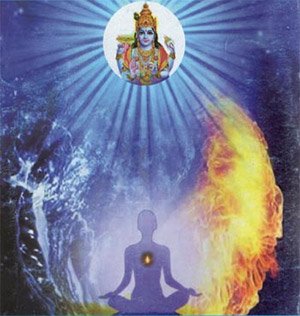Siddhanta Sangraha of Sri Sailacharya
by E. Sowmya Narayanan | 2008 | 30,562 words
Siddhanta Sangraha Chapter 2 (English translation), entitled “the explanation of the inert substances” as included in the critical edition and study. The Siddhanta Samgraha is a Sanskrit philosophical text dealing with Vishishtadvaita in five hundred Sanskrit verses. It was written by Shri Shailacarya (18th century) and closely follows the philosophy of Vedanta Deshika (13th century).
Chapter 2 - The Explanation of the Inert Substances
7. The substance jaḍa is two fold namely, avyakta (un-manifest) and kāla. The avyakta gets evolved into twenty four realities as mahat etc.
8. The avyakta is that in which the three qualities namely, sattva, rajas and tamas are in a state of equilibrium, among its evolutions eight principles become the cause for the sixteen modifications.[1]
9. From the aforesaid avyakta, because of the inequality of the three qualities mahat gets manifested as twenty three principles.
10. The first evolute of prakṛti is termed as mahat tattva. This mahat is three fold as. sāttvika, rājasa and tāmasa.
11. Though the three qualities are mixed with each other in the mahat when one quality becomes dominant and the other two are subsidiary to that, then the mahat is termed by the predominace only.[2]
12. There is no entity on earth or in the celestial region or among the Gods that is devoid of the three qualities evolved out of this prakṛti.[3]
13. The principle ahaṃkāra that is evolved from the mahat is also accepted to be three fold as sāttvikā etc.
14. The sāttvikāhaṃkāra is the material cause for the indriyas (sense organs). The tāmasāhaṃkāra is said to be the material cause for the five subtle elements (tanmātras)
15. The rājasāhaṃkāra which is in between the sāttvika and tāmasāhaṃkāra aids them in their function. We consider the argument that the mind is not a sense organs as improper.[4]
Footnotes and references:
[1]:
In this regard the author follows the Sāṅkhya’s theory of evolution. See Sāṅkhya Kārikā 3:—
mūlaprakṛtiravikṛtirmahadādyāḥ prākṛtivikṛtayaḥ sapta |
ṣoḍaśakastu vikāro na prakṛtirnavikṛtiḥ pūruṣaḥ ||
[2]:
When the sattva guṇa is dominant and rajas and tamas are less dominant then the mahat is termed as sāttvika. Similar is the case with other two qualities.—Cf. Sāṅkhya Kārikā-12
[3]:
Here, the author quotes the śloka from Bhagavad Gītā XVIII, 40.
[4]:
There is an argument by the naiyāyikas that the mind is only an instrument and not a sense organ. This view is criticized here.—Cf. “sukhādyupalabdhi sādhanam indriyam manaḥ |”—(Tarka Saṅgraha, p.52.)
Conclusion:
 This concludes The Explanation of the Inert Substances according to Vishishtadvaita philosophy explained by Shri Shailacarya. This book follows the model of Vedanta Deshika although the Vishishta Advaita school was originally expounded by Shri Ramanuja. Vishishta-Advaita is one of the various sub-schools of Vedanta which itself represents one of the six orthodox schools of Hindu Philosophy. They highlight the importance of the Upanishads, the Bhagavad Gita and the Brahma Sutras.
This concludes The Explanation of the Inert Substances according to Vishishtadvaita philosophy explained by Shri Shailacarya. This book follows the model of Vedanta Deshika although the Vishishta Advaita school was originally expounded by Shri Ramanuja. Vishishta-Advaita is one of the various sub-schools of Vedanta which itself represents one of the six orthodox schools of Hindu Philosophy. They highlight the importance of the Upanishads, the Bhagavad Gita and the Brahma Sutras.
